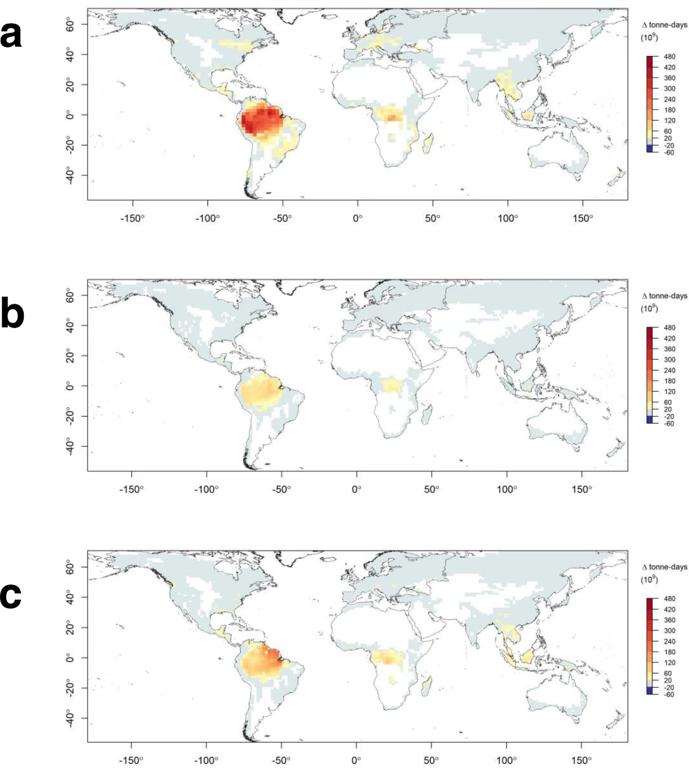Levels of fire activity and severity that are unprecedented in the instrumental record have recently been observed in forested regions around the world. Using a large sample of daily fire events and hourly climate data, here we show that fire activity in all global forest biomes responds strongly and predictably to exceedance of thresholds in atmospheric water demand, as measured by maximum daily vapour pressure deficit. The climatology of vapour pressure deficit can therefore be reliably used to predict forest fire risk under projected future climates.

Earth’s forests and woodlands have been marked by a string of mega-fires in recent years. Impacts on humans and ecosystems extend well beyond the footprint of these fires, which are increasingly occurring in areas and seasons not normally considered fire-prone. With their abundance of live and dead plant biomass (fuel), all forests and woodlands are inherently flammable. The drying out of fuel in these vegetation communities represents a critical transition to a higher risk state, with connected dry areas forming a template for any wildfires that occur. Major drying events can overcome natural barriers to fire spread such as relatively moist vegetation in gullies and in extreme cases allow fire to spread into rainforests and other fire-sensitive forest communities.
Quantifying the relationship between forest fire activity and variation in fuel moisture content thus provides a means for prediction of landscape fire potential, particularly when accompanied by spatially explicit predictions of fuel moisture content. The moisture content of fine dead plant material on the forest floor is a key determinant of fire properties and can be predicted from temperature and humidity, inputs for which a wide range of global, high-quality observational and modelling datasets are available. Vapour pressure deficit (VPD), which is calculated from air temperature and humidity, is a direct measure of the atmospheric demand for water and has been shown to be a reliable predictor of dead fuel moisture content in a range of forest and woodland biomes. VPD is also a key driver of plant mortality, causing declines in the moisture content of live fuels and an increase in the proportion of highly flammable dead fuels. VPD-based fuel moisture thresholds have been shown to be indicative of critical increases in the cumulative area burnt in south-east Australia and Mediterranean Europe. VPD itself has been found to be strongly associated with fire activity in boreal, temperate, Mediterranean and tropical forests.
Here, we identify VPD thresholds for the switching of global forest ecosystems from a prevailing humid and non-flammable state to a dry, flammable (i.e. ignitable) state. Our use of daily remotely sensed burned area and hourly climate reanalysis data is a key advance on previous studies, which typically focus on aggregate measures such as total area burnt over a season. Given this focus, models of the probability of successful ignition as a function of climate (i.e. daily maximum VPD) should provide a better identification of the critical fuel moisture threshold than models associated with total area burnt or the incidence of large fires. The latter may be confounded by additional factors such as fire suppression or the natural variation in area burned across biomes and regions. We develop generalised linear models of the probability of fire occurrence and use these models along with skill-selected global climate models to assess the impacts of climate change on the frequency of exceedance of fire activity thresholds (see Methods). We focus on the implications of changes in forest fire activity in two critical areas: carbon losses and human health impacts from wildfire smoke25,26. Pakistan last faced such dramatic and widesp We find that climate change is projected to lead to widespread increases in risk, with at least 30 additional days above critical thresholds for fire activity in forest biomes on every continent by 2100 under rising emissions scenarios. Escalating forest fire risk threatens catastrophic carbon losses in the Amazon and major population health impacts from wildfire smoke in south Asia and east Africa. read flooding in 2010.
Sources:
Nature Communications
https://www.nature.com/articles/s41467-022-34966-3 .
Provided by the IKCEST Disaster Risk Reduction Knowledge Service System
Comment list ( 0 )
